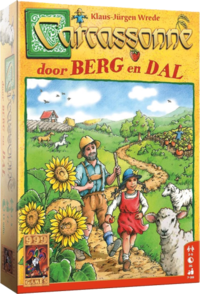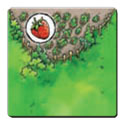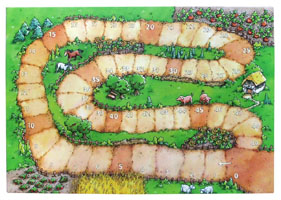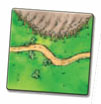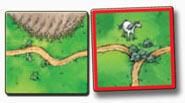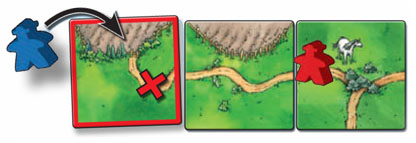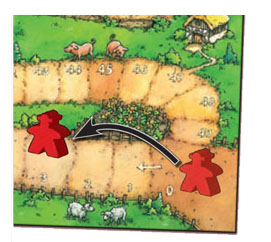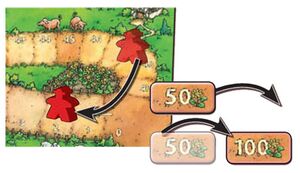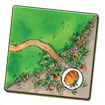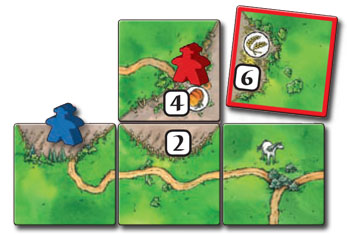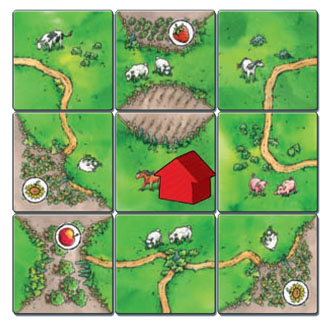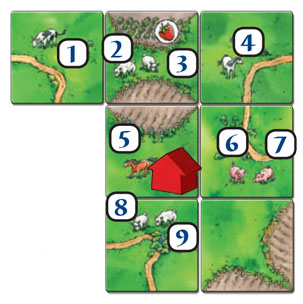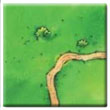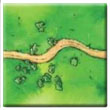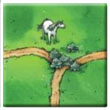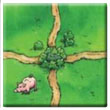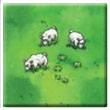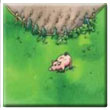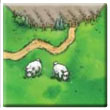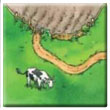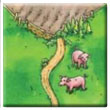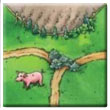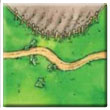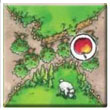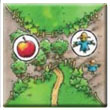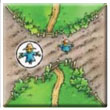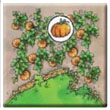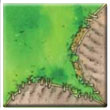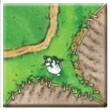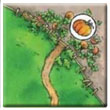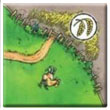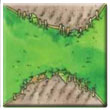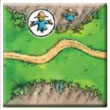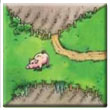Door Berg en Dal basisspel
Een listig legspel voor 2 tot 5 spelers vanaf 8 jaar.
Maak een wandeling door een prachtig landschap van fruitbomen, graanvelden en zonnebloemen! Niemand kan hier een sappige appel of zoete aardbei weerstaan.
Deze nieuwe Carcassonne variant geeft een vredig, landelijk gevoel, maar biedt ook nog steeds een strategisch spel. Wie de beste oogst heeft, ijverig rondtrekt en de meeste dieren bezit, heeft de beste kans op de overwinning.
Speelmateriaal en voorbereiding
Hartelijk welkom bij Carcassonne – door Berg en Dal! In deze handleiding leiden we jou door de spelregels van de nieuwste variant van de klassieker Carcassonne. Na het lezen van de spelregels kun je het spel gemakkelijk aan jouw medespelers laten zien en uitleggen. Al snel kun je genieten van een frisse nieuwe Carcassonne-ervaring.
Eerst moet je het spel klaarzetten, maar dat is heel gemakkelijk. Tijdens het klaarzetten leggen we kort het speelmateriaal uit.
Op de 73 landschapstegels zie je wegen en akkers, omringd door groene weiden. Op veel tegels staan ook dieren.
Eén van de 73 landschapstegels heeft een blauwe achterkant. Dit is de starttegel, waarmee elk spel begint.
Er zijn steeds 5 fiches met appels, aarbeien, pompoenen, zonnebloemen en graan. Verder zijn er 8 vogelverschrikkers.
Leg de starttegel in het midden van de tafel. Schud de overige tegels gedekt en maak er verschillende stapels van en leg die rond het speelveld zodat alle spelers er gemakkelijk bij kunnen. Sorteer de oogstfiches en leg ze in stapels aan de rand van de tafel.
Tenslotte hebben we nog het scorespoor dat je ook aan de rand van de tafel legt. Leg de 50/100-tegels ernaast. Die heb je later in het spel nodig als je meer dan 50 punten hebt vergaard.
Er zijn 25 meeples, 5 per kleur in de kleuren geel, rood, groen, blauw en zwart. Daarnaast zijn er 2 stallen per kleur. Elke speler begint met 4 meeples en 2 stallen. Deze vormen de voorraad van elke speler.
Zet de 5e meeple van elke speler zet je op veld 0 van het scorespoor. Alle meeples en stallen die niet door spelers gebruikt worden kunnen terug in de doos.
Doel van het spel
Voordat we de spelregels gaan uitleggen: wat is eigenlijk het doel van Carcassonne – door Berg en Dal? De spelers leggen om beurten landschapstegels aan. Zo bouw je wegen en akkers met groenten en fruit.
Jouw meeples kunnen wandelaar of boer worden en op de weiden kun je stallen bouwen. Dat levert zowel tijdens als na afloop van het spel punten op. Wie aan het einde de meeste punten heeft verzameld wint het spel!
Laten we beginnen!
Spelverloop
Carcassonne – door Berg en Dal wordt met de klok mee gespeeld. De jongste speler begint. De speler die aan de beurt is voert tijdens zijn beurt de volgende acties in de aangegeven volgorde uit. Daarna is de volgende speler aan de beurt, enzovoort. Laten we eens kijken welke acties er zijn en win welke volgorde die uitgevoerd worden. Dat doen we aan de hand van de tegels met wegen, akkers en weiden. Welke acties zijn er?
|
1. Landschapstegel leggen: De speler moet altijd een tegel trekken en die met minstens één zijde aan een al gelegde tegel leggen. |
2. Op de gelegde tegel mag de speler...
|
3. Puntentelling:
|
De wegen
1. Landschapstegel leggen
De tegel die je getrokken hebt heeft drie wegen vanuit een kruising. Je legt deze aan het bestaande landschap aan.
Merk op hoe deze langschapstegels aan elkaar passen.
2a. Een meeple als wandelaar inzetten
Nadat je de tegel hebt aangelegd, mag je op één van de wegen een meeple als wandelaar zetten. Dat mag echter alleen als er nog geen wandelaar op de weg staat.
De weg is nog niet afgesloten, dus volgt er nu nog geen puntentelling (actie 3), en de beurt gaat met de klok mee naar de volgende speler.
De volgende speler trekt en landschapstegel en legt die aan. Aangezien jouw wandelaar al op de weg links van de kruising staat, mag deze speler er geen meeple zetten. In plaats daarvan kiest hij ervoor om een meeple als boer op de akker van de zojuist aangelegde tegel te zetten.
Het is meestel goed om een meeple te zetten, maar nooit verplicht. Je mag er altijd voor kiezen om dat niet doen.
3. Puntentelling
Telkens als een weg aan beide zijden afgesloten wordt, wordt die geteld. De weg moet bij een kruising, een akker of bij zichzelf eindigen. Nu gaan we kijken of er een puntentelling volgt. Hoera! We tellen de weg omdat beiden kanten afgesloten zijn.
Het maakt niet uit wie de tegel heeft aangelegd, de weg is afgesloten en je krijgt er punten voor. Hoeveel punten krijg je? Elke tegel waaruit de weg bestaat levert 1 punt op.
Nu komt het scorespoor aan bod. Telkens als je punten krijgt, houd je die bij door jouw meeple vooruit te zetten op het scorespoor. Voortbordurend op ons voorbeeld, zet je jouw meeple 3 velden vooruit.
Na elke puntentelling neem je de meeple waarvoor punten geteld zijn terug in je voorraad.
Beurt na beurt verzamel je steeds meer punten. Zodra je het scorespoor rond bent en het 0-veld passeert, neem je een 50/100-tegel en leg je die met de 50 naar boven voor je neer. Lukt het je om het scorespoor een tweede keer rond te gaan, dan draai je de tegel om naar de kant met 100.
Met de volgende actie kun je nog meer punten met een weg krijgen!
3b. Wandelen met een wandelaar
Onder bepaalde voorwaarden, kun je nu met jouw meeple gaan wandelen.
Eén van jouw meeples moet op een weg staan. In stap 1 moet je een tegel aan deze weg hebben aangelegd. Daarna mag je met de meeple gaan wandelen, maar alleen als je in stap 2 geen meeple (of stal) gezet hebt.
Jij kiest de richting en verplaatst de meeple in die richting. Je krijgt 1 punt voor elke tegel waarop jouw wandelaar komt.
Daarbij mag jouw meeple de meeples van andere spelers passeren. Jouw meeple mag echter niet op een tegel eindigen waar al een andere wandelaar staat (d.w.z. meeple op een weg). Verwerk de punten op het scorespoor.
Belangrijke spelregels:
- Je mag geen kruising oversteken.
- Als je een tegel aanlegt waarmee een weg afgesloten wordt (wat een puntentelling veroorzaakt), mag jouw meeple vóór die puntentelling niet eerst gaan wandelen. Je krijgt per beurt maar één keer punten voor een weg.
- Je mag alleen tijdens je eigen beurt wandelen. Als een andere speler jouw weg uitbreidt, mag je niet wandelen.
- Je mag per beurt maar met één meeple gaan wandelen (ook als je meerdere wegen hebt uitgebreid).
Akkers
1. Placing a tile
Like always, you draw a tile and place it so that it extends the existing landscape. Naturally, fields must connect to other fields.
2. Placing a meeple as a farmer
Next, check if there is already a meeple in the field. If there aren't any, then you may place a meeple as a farmer in that field.
3. Scoring points
Scoring points for a completed field
On your next turn, you draw this tile. Fortunately, it fits your field perfectly. As luck would have it, it even completes the field.
Whenever a field is completely surrounded by meadow and has no holes, it is considered to be complete. Because you have a meeple in this completed field, you now score points for it. Each tile in the completed field scores 2 points.
Harvest tokens on a completed field
Not only do you score points for a completed field, you also gain Harvest tokens. The Harvest tokens are awarded at the same time as points are.
As the owner of the field, you gain 1 corresponding Harvest token for each harvest symbol in the completed field. You keep these collected Harvest tokens facedown in front of you (of course, you may look at your tokens during the game). You will score points for them at the end of the game.
After you have scored your points and collected your Harvest tokens, you return the meeple in the completed field to your supply.
Please see Multiple meeples on the same feature to read how the tokens are awarded when there are multiple farmers in the same completed field.
The Stables
1. Placing a tile
Like always, you draw a tile and place it so that it extends the existing landscape.
2b. Placing a stable
You begin the game with 2 stables in your supply. Stables can only be placed on a meadow depicted on a tile you just placed. If there are several sections of meadow, you may choose which one to place it on. Don't forget: You must decide between placing a meeple, placing a stable, or hiking with a wanderer. You can only perform one of these three actions.
When placing a stable, you must follow one important rule: you may only place a stable on a tile if none of the 8 tiles surrounding it (orthogonally or diagonally) have a stable on them. This rule is only for stables, not for meeples!
Once a stable is placed, it remains there until the end of the game, at which time it may score you points.
It is recommended that you place stables on and bordering tiles with many animals. Each animal is worth 1 point at the end of the game.
3. Scoring points
No points are scored for stables while the game is being played. Stables are only scored at the end of the game (see Game End and Final Scoring). At that time, players will score 1 point for each animal on the tiles surrounding their stable.
Summary
1. Placing a tile
- The Land tile that you draw must be placed so that it extends the existing landscape (i.e., the illustration).
- In some very rare cases, it may be impossible to place a drawn tile. In those cases, simply place the tile in the box and draw a new one.
2. Placing a meeple or a stable
- You may only place a meeple or stable on the tile you just placed.
- You may not place a meeple/stable in a feature already occupied by another meeple/stable.
- You must follow the important stable placement rule: there may not be a stable on any adjacent tile.
3. Scoring points or hiking with a wanderer
- A path is complete when both ends lead to a junction, a field, or form a closed loop. Each tile in a completed path is worth 1 point.
- You may hike when you extend a path, without completing it, occupied by your own meeple. However, you must not have placed a meeple or stable in the same turn. For each tile that the wanderer hikes to, score 1 point.
- A field is complete when it is completely surrounded by meadow and has no holes. Each tile in a completed field is worth 2 points, and each harvest symbol is worth 1 Harvest token.
- Scoring always occurs at the end of a player's turn. All players with meeples in newly completed features have the opportunity to score points.
- After each scoring, return meeples on completed paths/fields to the players' supplies.
- If there are multiple players in a scored feature, the player with the most meeples is awarded the full points, and all other players score nothing. When more than one player has the most meeples in a scored feature, all tied players score full points.
(Note: How can there be more than one meeple in a feature? To find out, read the examples below.)
Multiple meeples on the same feature
Multiple meeples on a path
Multiple meeples in a field

Distribution of Harvest tokens among multiple farmers
As previously explained, you receive 1 Harvest token for each corresponding harvest symbol in a completed field.
If more than one player has the most farmers in a completed field, then the Harvest tokens are distributed as follows:
- First, gather all the Harvest tokens that will be awarded from their respective supplies.
- Then all players tied for most farmers in that field take turns taking Harvest tokens. Start with the player who placed the tile to complete the field, or (if this player is not one of the tied players) the first tied player clockwise.
- This continues until all the awarded Harvest tokens have been taken. It is possible that some players will receive more Harvest tokens than others.
Game End and Final Scoring
Sadly, all good things must come to an end, and the same is true for Carcassonne – Over Hill and Dale. 'Tis a pity, but now we must determine the winner. The game ends after the turn of the player who placed the last tile. Then we proceed to final scoring, after which the winner will be known to all!
Once the game is over, you score points for the following:
Paths
Each incomplete path is worth 1 point per tile, just like during the game.
Fields
Each incomplete field is worth 1 point per tile, which is half the points. Harvest tokens are not awarded during final scoring!
Stables
For each stable, count the animals on the tile the stable occupies and the 8 tiles that surround it. Count every animal (rooster, cow, horse, sheep, and pig) on these 9 tiles. Each animal is worth 1 point.
Harvest Tokens
Each Harvest token is worth 1 point (even the scarecrow). In addition, each set of 5 different fruit tokens (1 each of apple, strawberry, pumpkin, sunflower, and grain) is worth an additional 5 points. Scarecrows may be used as wild tokens, replacing any 1 fruit in a set.
The Winner
Move your scoring meeple forward on the scoreboard to mark the points you are awarded during final scoring.
Whoever has scored the most points is the winner!
If there is a tie for the most points, the players rejoice in a shared victory! Congratulations!
Tile Distribution
Total Regular Tiles: 73
Note: Tiles with multiple versions have various distributions of animals and harvest symbols.
Total Tokens: 33
Voetnoten
Kijk op de Pictogrammen pagina voor uitleg over en licensering van de pictogrammen.
